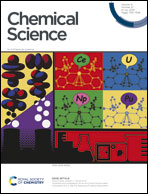Shape tunability of copper nanocrystals deposited on nanorods†
Abstract
The significant role of metal particle geometry in dictating catalytic activity, selectivity, and stability is well established in heterocatalysis. However, this topic is rarely explored in semiconductor–metal hybrid photocatalytic systems, primarily due to the lack of synthetic control over this feature. Herein, we present a new synthetic route for the deposition of metallic Cu nanoparticles with spherical, elliptic, or cubic geometrical shapes, which are selectively grown on one side of the well-established CdSe@CdS nanorod photocatalytic system. An additional multipod morphology in which several nanorod branches are combined on a single Cu domain is presented as well. Cu is an earth-abundant low-cost catalyst known to promote a diverse gallery of organic transformations and is an excellent thermal and electrical conductor with interesting plasmonic properties. Its deposition on cadmium chalcogenide nanostructures is enabled here via mitigation of the reaction kinetics such that the cation exchange reaction is prevented. The structural diversity of these sophisticated nanoscale hybrid systems lays the foundations for shape–activity correlation studies and employment in various applications.



 Please wait while we load your content...
Please wait while we load your content...